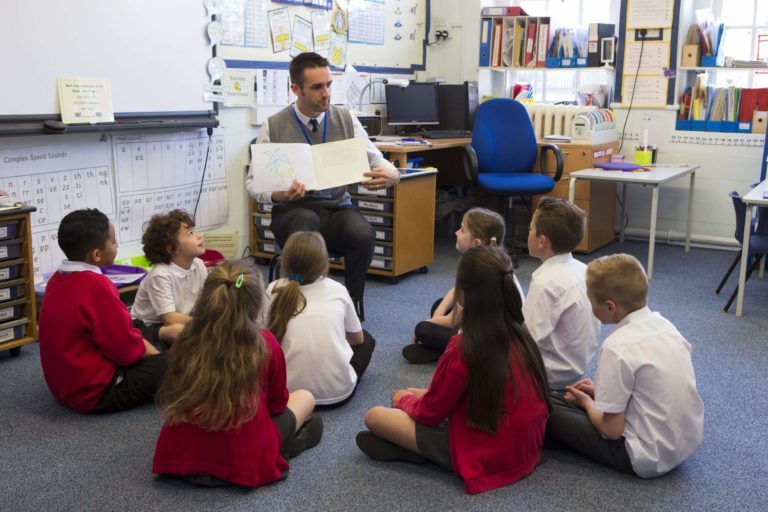One of my favorite concepts to teach in my English classroom is theme. The concept often seems broad and intimidating to students – like they must have an optimal level of intellectual depth in order to extract a theme from literature. It’s a concept that I struggled to relay before I implemented storytelling.
I invite my students to travel back with me to yesteryear, a time when streaming services had not yet been born. I tell them about the anticipation I felt every Friday evening as my sisters and I parked on the couch to indulge in ABC’s TGIF line-up. I explain the tragic loss of cool points on the morning school bus ride for those who missed the previous night’s hit show and had nothing to add to the routine recap. Then, I tell them that the most memorable part of these experiences was the theme songs. These songs encapsulated the essence of each show, and inspired many sing-your-heart-out family moments in my household. Finally, I invite my students to collaboratively analyze theme as portrayed through the nostalgia of 90s sitcom theme song lyrics. This is storytelling in the classroom. It wins every single time and is a valuable, cross-curricular tool.
Get Personal
Effective classroom storytelling cannot exist apart from transparency. When you tell stories about your experiences, students get a rare and valuable window into who you are and how they can relate to you. One of my favorite ways to incorporate storytelling is telling students about my imperfections as a former student. They particularly like the story about how senioritis almost cost me my graduation due to a failing AP economics grade. These stories humanize me before my students, and it inspires them to push past their own shortcomings and give themselves grace. Believe it or not, some students who seem unmotivated are suffering from a lack of self-forgiveness for their own mistakes.
Aside from sharing about your academic experiences, you can share other personal experiences as relevancy arises. My students love hearing funny stories about sibling rivalries when we analyze family culture, and they also appreciate me sharing the challenges my Muslim-American grandfather faced following the September 11th terrorist attacks. Personal stories can range from light-hearted to deep and will go a long way when building rapport with your students.
Storytelling Builds Valuable Skills
Storytelling isn’t only valuable because of the bridges it builds between you and your students; it also works to develop valuable skills in the classroom. Students learn to become active and critical listeners through storytelling. Stories are typically far more engaging than lectures, thus students are more likely to truly tune in and interact. They automatically begin making connections, evaluating actions and motives, and forming questions. These are the interpersonal communication skills that our students desperately need but often can’t learn through lectures and notes.
The ability to build complex questions based upon information is a key to effective communication. This is an excellent by-product of storytelling in the classroom. Students are intrigued by your story and ask questions that cause you to provide more detail. Without knowing, students are building effective interviewing skills and engaging in inquiry-based learning.
Teaching Content through Storytelling
As an English teacher, storytelling feels both natural and necessary. Teachers of other content areas may take our natural inclination to tell stories in the English classroom as evidence that storytelling is unsuitable for their classrooms. This is a misconception, however, as storytelling is applicable to all subject areas.
Math, though seemingly the most ill fit, presents a plethora of opportunities for classroom storytelling. Imbedding numbers into a story to relay a word problem is one example. In a geometry class, for example, the teacher could tell a story that includes different shapes and angles observed. This not only enhances students’ mathematical skills, but it also serves your auditory learners well and provides a different exposure to word problems.
I learned the power of storytelling in the history classroom while making historical connections in my American literature class. When we read August Wilson’s The Piano Lesson, for example, I told students a story about The Great Migration and what factors persuaded African American families to move north. This piqued students’ interest in the novel and encouraged them to ask critical questions about characters and their decisions throughout our study.
Science is not excluded from the storytelling effect. I distinctly remember writing a story about a young boy who shrunk and got stuck inside a cell for my seventh-grade science class. This storytelling experience has cemented the cell parts and their functions in my brain all these years later.
Interactive Storytelling
When you implement storytelling in the classroom, the act does not have to be a one-man-show. You can include your students in your endeavors through interactive storytelling. During interactive storytelling, students are invited to pose questions, chime in, act out scenes, and much more while a teacher tells a story. The possibilities are endless, and the engagement is always high!
Unfortunately, the prevalence of storytelling has decreased in our society over the years, but we can keep this art alive in our classrooms. Listening is a most important skill of communication, and this is a sure way to build those skills. Finding ways to incorporate storytelling in your classroom will build rapport and increase engagement.




